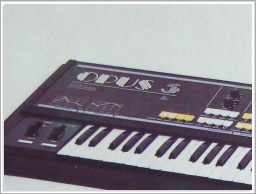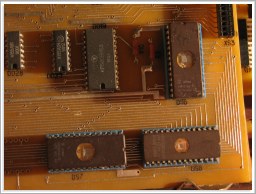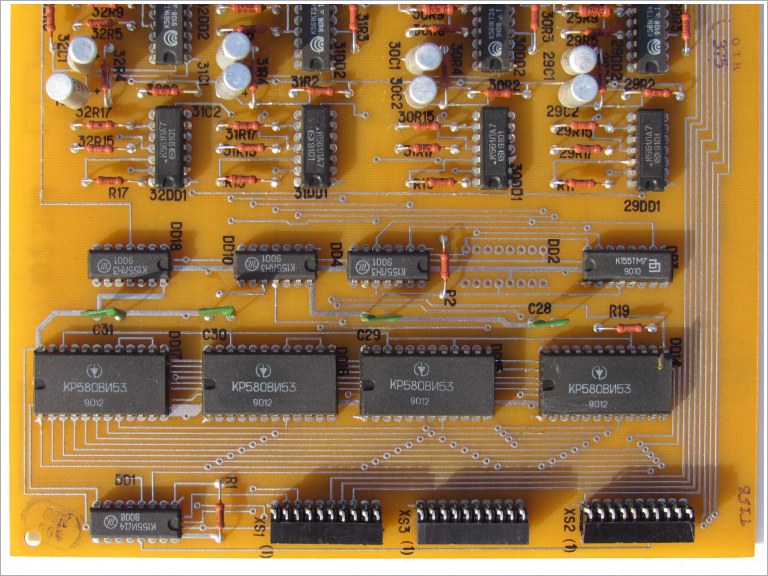RMIF TI-3 and TI-5 synthesizers
Factory that was producing them (RMIF) no longer exists
(for about 15-20 years already), along with the Soviet Union (USSR)
itself.
Unfortunately TI-s are very poorly designed and brake for no reason.
There are barely any working TI-s in the world. And if you happen to be
the one having a working TI - don't get too excited as it can just stop
working at any moment. And what makes this even worse -
there are no schematics of it anywhere to be found. They just dont
exist. I assume that all schematics were just exchanged for vodka by
the original engineers, or just lost.
There is a rumour, that I will soon investigate, that one designer is
(for some reason) still alive, and has the schematics. Being unable to
do aynthing good, he sells access to the old schematics
(disallowing to
copy) for 100eur per paper... If he actually exists, I will find him,
and everything he has will be open online here for free.
Anyways, I have reverse engineered and drawn some schematics of it. Soon I hope
to finilize my findings and post everything here. Currently there is no
information on the net regarding repair of TI-3/5. It seems that
anyone of those, who have figured out some inner workings of it, are keeping
everything in secret as an information of incredible strategic value...
What kind-of shows what nada their lives are worth. ;)
So owning such a synth basicaly requires the user to be able to fix it. Frequently.
Technically, synth is far from something fabulous:
- Digital part of the sound source (digital wave generator) consists of
eight "PC-Speaker" chips from cloned PC-XT chipset (yes, the PIT chip 82c53), one
for each voice. While original intel 82C53 are long living parts,
russian clones die for no reason. My first TI-3 had two (of 8) already dead.
-
Analog processing (VCFs and VCAs) part is a huge array of discrete
analog parts, containing scary amounts of unreliable KT315/KT361
transistors and soviet capacitors.
- Everything is controlled by an 8080 cpu clone - soviet K580IK80
(К580ИК80) chip. It's extreme slowness is also accompanied be very
clumsy software. Knobs are read by it in software and audibly updated at less than four times per second... (yes,
turning a knob makes filter and other settings abruptly jump - nothing even remotely
"real time" or "live")
- Dynamic Voice Allocation engine is a total mess and does not realy
work. It's comparable to and generaly slightly worse than DVAs of chinese
toy keyboards.
Somewhere this summer I plan to systematize all of the information I
have reverse engineered out of these things. Then I'll post it there as
soon as I will digitize that information.
If you happen to be a keen oldschool 8080 assembly&disassembly
coder, wanting to do some digging into obscure soviet code, drop me a
line! I plan to create an alternative/patched/fixed firmware for both
TI-3 and TI-5 with fixed DVA and added test mode (likely in a form of a
separate ROM set due to low available space). Test mode is a critical
necessity for the keyboard diagnostics in field. As soon as it will get
made, it will be available down there for free!
Regarding sounds, you can check the awesome Ruskeys.Net website.
 |
TI stands for "Taustiņu Instruments" in latvian, literary meaning "Keyboard Instrument". Before TI it was called RMIF OPUS-3. |
 |
|
Page still under development. Sorry :)
Wave generator board
Wave
generator of RMIF TI is made of two almost identical boards, each
containing circuitry for four voices. Every voice has an independant
i8253 (КР580ВИ53) timer chip, four s&h for analog controls, and a common (for all four voices) 4bit latch for wave
shaping
mux settings. Therefore waveform (instrument) settings can only be set
per board, not per voice. Dual/split voice mode is achieved by using
two boards, and therefore upper and lower parts allways have fixed
polyphony of 4 voices.
Although resonance has independant individual s&h for every voice, system controller does not make use of this feature.

Four КР580ВИ53 chips for four voices. A 4bit latch (К155ТМ7) gets
soldered into position DD3 or DD2 depending on board location in synth
- upper or lower. Click for larger view.
|
Control port pinouts and diagrams will be there eventually.
Whenever I will manage to scrap up more of my old papers, I am going to
gradually fill this void up.
ROM chips
IF YOU HAVE A TI-3/5 and have an access to a ROM reader, please read chip contents, take a photo of the board and send me, so I can compare and post them out if it is of a different version.
(Russian) ЕСЛИ У ТЕБЯ ЕСТЬ RMIF TI-3 ИЛИ TI-5, то было бы просто сказочно, если поделишся
прошивками РФ'ок. Если у тебя нет ROM reader'а, то у соседа он точно
есть. Надо, наконец, собрать всё техническое о этих синтах в одно место.
Дорогие жмоты, паталогически скупые "ЛЕНИНГРАДСКИЕ МАСТЕРА" и другие
полудурки - продолжайте сидеть на своих сраных секретных схемах и
прошивках, тем самым подтверждая свою малоценность и чмошность.
(Latvian) JA TEV IR TI-3 vai TI-5,
pat ja nestrādājošs, tad būtu neparasti pasakaini, un pilnīgi
neraksturīgi latviskajam skopajam garam, ja padalītos ar ROM čipu
saturu vienkārši tā pat. Es pat varu atbraukt, atskrūvēt sinti un nokopēt čipus ar savu
lasītaju, ja tas ir Rīgas rajona robežās. Nav ko skopoties un lielos biznesa
plānus kalt, jo, kad pašam tie ROMi nojūgsies (a padomju РФ ir vareni
amnēziski), tad pašam arī tie noloasītie imidži noderēs.
ROM chip images for TI-3
| IC pos. |
IC type |
IC contents |
Data image |
| DS6 |
27С64 or К573РФ6 |
Program for К580ИК80 |
Get the bin and hex files |
| DS7 |
27С64 or К573РФ6 | log scale in unsigned 16bit intel word format |
Get the bin and hex files |
| DS8 |
27С64 or К573РФ6 | timbre presets (192x 32byte records; 192 = 64 presets x3 banks) |
Get the bin and hex files |
ROM chip images for TI-5
| IC pos. |
IC type |
IC contents |
Data image |
| DS6 |
27С64 or К573РФ6 | Program for К580ИК80 |
Get the bin and hex files |
| DS7 |
27С64 or К573РФ6 | some more program code and a log scale |
Get the bin and hex files |
| DS8 |
27С64 or К573РФ6 | timbre presets and some more program code |
Get the bin and hex files |
There was also a TI-5 mainboard version, that had only one ROM chip:
| IC pos. |
IC type |
IC contents |
Data image |
| DS8 |
27C256 |
Program for К580ИК80 combined with log scale and timbre presets |
missing |
Thanks:
Paldies Jānim Vīksnam par sagādātajiem TI-5 ROM'iem!
Also thanks go to Bart Jaspers from the Netherlands for yet another TI-5 ROM dumps, that confirmed the ones I had to be flawless originals.